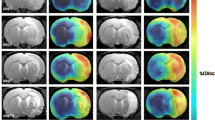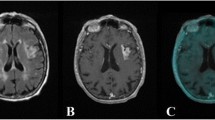Abstract
To evaluate the effect of bevacizumab on cerebral ischemia, we used 2-deoxy-2-18F-fluoro-D-glucose (18F-FDG) small-animal positron emission tomography (PET) in the middle cerebral artery occlusion (MCAO) rat model. After baseline neurologic function tests and PET studies, MCAO Sprague-Dawley rats received bevacizumab or normal saline (controls). Weekly PET imaging and neurologic function tests showed that the 18F-FDG accumulation in the bevacizumab group was similar to that in the controls during the first 2 weeks, but lower than in controls at weeks 3 and 4. However, no difference was found in neurological scores between the groups. The number of von Willebrand factor-positive cells in the bevacizumab group was lower than that in controls. The expression of vascular endothelial growth factor was higher than in controls at week 4. These results suggested that bevacizumab does not influence functional recovery in this model of cerebral ischemia during a 4-week period, but inhibits vascular formation and metabolic recovery, which may be considered in cancer patients with a recent ischemic stroke.
Similar content being viewed by others
References
Tang Z, Zhou T, Luo Y, Xie C, Huo D, Tao L, et al. Risk factors for cerebrovascular disease mortality among the elderly in Beijing: a competing risk analysis. PLoS One 2014, 9: e87884.
He J, Gu D, Wu X, Reynolds K, Duan X, Yao C, et al. Major causes of death among men and women in China. N Engl J Med 2005, 353: 1124–1134.
Feigin VL, Lawes CM, Bennett DA, Barker-Collo SL, Parag V. Worldwide stroke incidence and early case fatality reported in 56 population-based studies: a systematic review. Lancet Neurol 2009, 8: 355–369.
Pappachan J, Kirkham FJ. Cerebrovascular disease and stroke. Arch Dis Child 2008, 93: 890–898.
Graus F, Rogers LR, Posner JB. Cerebrovascular complications in patients with cancer. Medicine (Baltimore) 1985, 64: 16–35.
Kim SJ, Park JH, Lee MJ, Park YG, Ahn MJ, Bang OY. Clues to occult cancer in patients with ischemic stroke. PLoS One 2012, 7: e44959.
Ferrara N, Hillan KJ, Gerber HP, Novotny W. Discovery and development of bevacizumab, an anti-VEGF antibody for treating cancer. Nat Rev Drug Discov 2004, 3: 391–400.
The FDA approves drugs for colorectal cancer, lung cancer. FDA Consum 2007, 41: 5.
Cloughesy T. FDA accelerated approval benefits glioblastoma. Lancet Oncol 2010, 11: 1120.
Summers J, Cohen MH, Keegan P, Pazdur R. FDA drug approval summary: bevacizumab plus interferon for advanced renal cell carcinoma. Oncologist 2010, 15: 104–111.
Hershman DL, Wright JD, Lim E, Buono DL, Tsai WY, Neugut AI. Contraindicated use of bevacizumab and toxicity in elderly patients with cancer. J Clin Oncol 2013, 31: 3592–3599.
Scappaticci FA, Skillings JR, Holden SN, Gerber HP, Miller K, Kabbinavar F, et al. Arterial thromboembolic events in patients with metastatic carcinoma treated with chemotherapy and bevacizumab. J Natl Cancer Inst 2007, 99: 1232–1239.
Vaughn C, Zhang L, Schiff D. Reversible posterior leukoencephalopathy syndrome in cancer. Curr Oncol Rep 2008, 10: 86–91.
Marinella MA, Markert RJ. Reversible posterior leucoencephalopathy syndrome associated with anticancer drugs. Intern Med J 2009, 39: 826–834.
Phelps ME, Hoffman EJ, Mullani NA, Ter-Pogossian MM. Application of annihilation coincidence detection to transaxial reconstruction tomography. J Nucl Med 1975, 16: 210–224.
Gallagher BM, Fowler JS, Gutterson NI, MacGregor RR, Wan CN, Wolf AP. Metabolic trapping as a principle of oradiopharmaceutical design: some factors resposible for the biodistribution of [18F] 2-deoxy-2-fluoro-D-glucose. J Nucl Med 1978, 19: 1154–1161.
Tatsch K. Positron emission tomography in diagnosis and differential diagnosis of Parkinson’s disease. Neurodegener Dis 2010, 7: 330–340.
Bohnen NI, Frey KA. The role of positron emission tomography imaging in movement disorders. Neuroimaging Clin N Am 2003, 13: 791–803.
Kim YK, Lee DS, Lee SK, Kim SK, Chung CK, Chang KH, et al. Differential features of metabolic abnormalities between medial and lateral temporal lobe epilepsy: quantitative analysis of (18)F-FDG PET using SPM. J Nucl Med 2003, 44: 1006–1012.
Herholz K, Heiss WD. Positron emission tomography in clinical neurology. Mol Imaging Biol 2004, 6: 239–269.
Kosaka N, Tsuchida T, Uematsu H, Kimura H, Okazawa H, Itoh H. 18F-FDG PET of common enhancing malignant brain tumors. AJR Am J Roentgenol 2008, 190: W365–369.
Hong YT, Veenith T, Dewar D, Outtrim JG, Mani V, Williams C, et al. Amyloid imaging with carbon 11-labeled Pittsburgh Compound B for traumatic brain injury. JAMA Neurol 2014, 71: 23–31.
Cash SS, Larvie M, Dalmau J. Case records of the Massachusetts General Hospital. Case 34-2011: A 75-year-old man with memory loss and partial seizures. N Engl J Med 2011, 365: 1825–1833.
Singhal T. Positron emission tomography applications in clinical neurology. Semin Neurol 2012, 32: 421–431.
Phelps ME. Positron emission tomography provides molecular imaging of biological processes. Proc Natl Acad Sci U S A 2000, 97: 9226–9233.
Shalhoub J, Oskrochi Y, Davies AH, Owen DR. Clinical assessment of carotid atherosclerosis inflammation by positron emission tomography. Curr Mol Med 2013, 13: 1646–1652.
Wang J, Chao F, Han F, Zhang G, Xi Q, Li J, et al. PET demonstrates functional recovery after transplantation of induced pluripotent stem cells in a rat model of cerebral ischemic injury. J Nucl Med 2013, 54: 785–792.
Curtin LI, Grakowsky JA, Suarez M, Thompson AC, DiPirro JM, Martin LB, et al. Evaluation of buprenorphine in a postoperative pain model in rats. Comp Med 2009, 59: 60–71.
Garcia JH, Wagner S, Liu KF, Hu XJ. Neurological deficit and extent of neuronal necrosis attributable to middle cerebral artery occlusion in rats. Statistical validation. Stroke 1995, 26: 627–634; discussion 635.
Bang OY, Seok JM, Kim SG, Hong JM, Kim HY, Lee J, et al. Ischemic stroke and cancer: stroke severely impacts cancer patients, while cancer increases the number of strokes. J Clin Neurol 2011, 7: 53–59.
Chowdhary S, Chamberlain M. Bevacizumab for the treatment of glioblastoma. Expert Rev Neurother 2013, 13: 937–949.
Wang CJ, Huang KE, Sun YC, Yang YJ, Ko JY, Weng LH, et al. VEGF modulates angiogenesis and osteogenesis in shockwave-promoted fracture healing in rabbits. J Surg Res 2011, 171: 114–119.
Yang H, Jager MJ, Grossniklaus HE. Bevacizumab suppression of establishment of micrometastases in experimental ocular melanoma. Invest Ophthalmol Vis Sci 2010, 51: 2835–2842.
Lu Y, Zhou N, Huang X, Cheng JW, Li FQ, Wei RL, et al. Effect of intravitreal injection of bevacizumab-chitosan nanoparticles on retina of diabetic rats. Int J Ophthalmol 2014, 7: 1–7.
Ishrat T, Pillai B, Soliman S, Fouda AY, Kozak A, Johnson MH, et al. Low-dose candesartan enhances molecular mediators of neuroplasticity and subsequent functional recovery after ischemic stroke in rats. Mol Neurobiol 2014.
Li YN, Pan R, Qin XJ, Yang WL, Qi Z, Liu W, et al. Ischemic neurons activate astrocytes to disrupt endothelial barrier via increasing VEGF expression. J Neurochem 2014, 129: 120–129.
Stewart MW. Predicted biologic activity of intravitreal bevacizumab. Retina 2007, 27: 1196–1200.
Sinapis CI, Routsias JG, Sinapis AI, Sinapis DI, Agrogiannis GD, Pantopoulou A, et al. Pharmacokinetics of intravitreal bevacizumab (Avastin(R)) in rabbits. Clin Ophthalmol 2011, 5: 697–704.
Author information
Authors and Affiliations
Corresponding author
Additional information
These authors contributed equally to this work.
Rights and permissions
About this article
Cite this article
Dong, Y., Song, F., Ma, J. et al. Small-animal PET demonstrates brain metabolic change after using bevacizumab in a rat model of cerebral ischemic injury. Neurosci. Bull. 30, 838–844 (2014). https://doi.org/10.1007/s12264-014-1470-z
Received:
Accepted:
Published:
Issue Date:
DOI: https://doi.org/10.1007/s12264-014-1470-z




